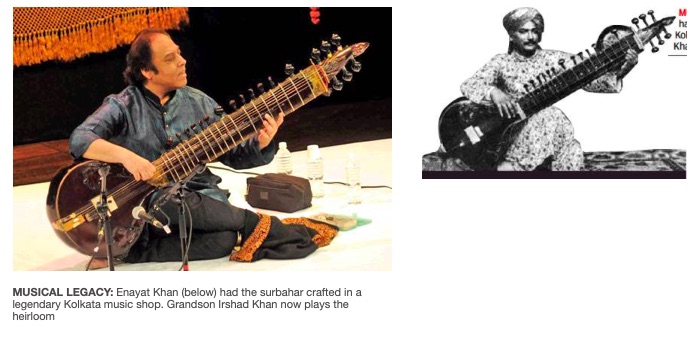Surbahar
This is a collection of articles archived for the excellence of their content. |
A brief history
Malini Nair, How a 100-yr-old instrument is wowing music lovers, March 24, 2019: The Times of India

From: Malini Nair, How a 100-yr-old instrument is wowing music lovers, March 24, 2019: The Times of India
Enayat Khan’s beautiful old surbahar gets a new lease of life, thanks to his grandson
As unseasonal clouds gathered over the massive ramparts of Qila Mubarak, a question mark hung over the evening concert at the Patiala Heritage Festival. Would the rain hold off for the Khan string trio comprising brothers Irshad, Nishat and Wajahat to come together for a rare ensemble of surbahar, sitar and sarod?
As frantic parleys began, Irshad Khan sat in a corner of the green room, brows furrowed, and protective hands running tentatively over his surbahar. There was no way he could risk venturing out with his saaz, an heirloom of the Imdadkhani-Etawah gharana that goes back seven generations.
His surbahar had been crafted nearly 100 years ago at Kanailal and Brother, a legendary music shop on Kolkata’s Upper Chitpur Road in the Burrabazaar area whose illustrious clientele included Enayet Khan, Vilayat Khan, and Ravi Shankar.
Sometime in the early years of the last century, the surbahar-sitar genius, Ustad Enayet Khan, had stood over the luthiers at Kanailal and instructed them as they shaped this mighty surbahar, an instrument that’s often called the bass sitar. It had been an extravagant investment — somewhere between Rs 10,000-20,000, his son Imrat Khan, brother of the sitar maestro Vilayat Khan, was to later recall.
Imrat handed it down to Irshad.
Beautiful and fragile, the squat surbahar with its almost flat tumba (gourd) is a work of art in itself, and if you heard its deep, mellow sounds, you could understand what the fuss was about.
In a television interview, Imrat Khan recounted the tale behind the survival of the antique instrument. Enayat Khan had died young, in 1936 at age 43, leaving the family in disarray. By 1942, with the threat of Japanese attack over Kolkata looming, life had got even tougher for the family.
The surbahar now stood forlorn. Vilayat Khan, at 14, had picked the sitar and was already a prodigy with it. Despite hardships, their mother, the doughty Bashiran Begum, refused to put the surbahar in the market. The matriarch then decided on its next owner — Imrat Khan, then all of seven. He went on to become one of the most renowned players of the instrument, often sitting in on a duet with his brother on the sitar.
Irshad says he himself was just a bit more than a toddler when he was started on the surbahar, impressing his father and uncle with the strength with which he pulled the strings. In a sort of historic parallel to his father and uncle’s choices, Nishat plays the sitar, while Irshad plays both the surbahar and sitar. Wajahat, the youngest, took to the sarod.
With its grand, low sounds — gambhir (serious) rasa, as Irshad puts it — the surbahar is increasingly fading from the popular classical landscape. Its grandeur shines through in grave ragas such as Malkauns and Darbari and when accompanied by the deep notes of the pakhawaj. The sitar is far more of a crowd pleaser, with its ebullient notes that lend themselves to fast taans and sawal jawab with the equally perky tabla.
“Contrary to popular views, the surbahar is not a big sitar. It is closer to the rudra veena — deeply resonant but a heavy, hard instrument to handle. This is why we are now down to half a dozen specialists. It takes a lot of riyaaz and hard work,” says veteran musicologist Lalita Khanna who recalls seeing the old surbahar in the Shimla home of Vilayat Khan.
Irshad has a doubly tough task of getting his grand old surbahar to stay in the fray. “It sounds great but its volume has declined over the decades. So playing it solo itself is hard work. Then if I play with another instrument, it becomes really problematic (because it will be barely audible). So imagine the balancing act of playing it with the sitar and the sarod and then having a pakhawaj and tabla in the mix,” he says.
Barely a fortnight before, the brothers had played their first trigalbandi (trio) at the NCPA in Mumbai to rave audience reviews. Irshad is still uncertain the almost centenarian surbahar could make itself heard in an ensemble. As it happened, rains did wash out the Patiala concert that evening.
But wrapping the antiquated surbahar in cotton-wool and leaving it on a shelf is the last thing Irshad wants to do. “There is no way you will get this sweetness of sound out of any other instrument. Given its special power, you have to literally wring the music in it. You actually need physical prowess to coax it,” he says. So while Irshad, who divides his time between Kolkata and Ontario, has a new surbahar, he is increasingly bringing out the heirloom to play at public concerts.
“I usually travel with both a surbahar and a sitar and play both or one. The surbahar, however, needs an audience that can sit, listen and savour music. This is not fast entertainment. It never can be,” he says.